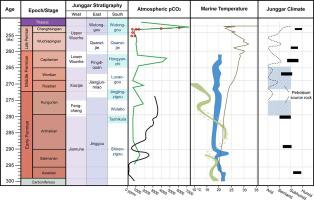当前位置:
X-MOL 学术
›
J. Asian Earth Sci.
›
论文详情
Our official English website, www.x-mol.net, welcomes your
feedback! (Note: you will need to create a separate account there.)
Paleoenvironmental setting, mechanism and consequence of massive organic carbon burial in Permian Junggar Basin, NW China
Journal of Asian Earth Sciences ( IF 2.7 ) Pub Date : 2020-06-01 , DOI: 10.1016/j.jseaes.2019.104222 Yuan Gao , He Huang , Huifei Tao , Alan R. Carroll , Jianming Qin , Jiquan Chen , Xiaoguang Yuan , Chengshan Wang
Journal of Asian Earth Sciences ( IF 2.7 ) Pub Date : 2020-06-01 , DOI: 10.1016/j.jseaes.2019.104222 Yuan Gao , He Huang , Huifei Tao , Alan R. Carroll , Jianming Qin , Jiquan Chen , Xiaoguang Yuan , Chengshan Wang

|
Abstract The Junggar Basin in northwestern China is a typical “walled” sedimentary basin that has a prolonged basin evolution history from the Paleozoic to Cenozoic and is rich in petroleum resources. Permian strata reach thousands of meters in thickness and have been intensively studied for their record of regional tectonics and paleoenvironments. They have also been exploited for oil and gas for the past several decades. In this paper, we summarize perspectives on tectonic evolution, stratigraphic framework, sedimentary environments, and the paleoclimate of the Permian Junggar Basin and the adjacent Turpan Basin. Further, we discuss the mechanism and consequences of massive organic carbon burial. Based on a compilation of published radiometric dating datasets, an updated chronostratigraphic framework was proposed for the Junggar Basin. This framework constrains the ages of two main petroleum source intervals, the Fengcheng Formation and the Lucaogou and equivalent formations, as Early Permian and Middle Permian, respectively. Although a global warming and drying trend was present throughout the Permian Period, the regional climate over the Junggar Basin was drier in Early Permian and more humid in the Middle-Late Permian with short-term climatic fluctuations. During the deposition of the two petroleum source intervals, dry and temperate climate prevailed and evaporative lacustrine environment dominated. Organic matter enrichment was promoted by stable salinity stratification and limited dilution by inorganic sediments, leading to one of the richest lacustrine source rock deposits in the world. The average organic carbon burial rates were 11.2 gC/m2/yr for the Lucaogou Formation and 3.5 gC/m2/yr for the Fengcheng Formation, lower than the average organic carbon burial rate in modern lakes. However, considering the large areas of global tectonic lakes in the Permian Period, organic carbon burial in lacustrine environments could act as a significant carbon sink and impact the global carbon cycle and climate evolution.
更新日期:2020-06-01











































 京公网安备 11010802027423号
京公网安备 11010802027423号